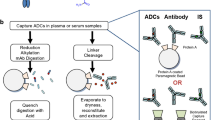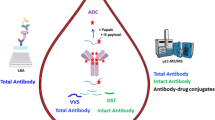Abstract
High-performance liquid chromatography–tandem mass spectrometry (LC-MS/MS) and enzyme-linked immunosorbent assay (ELISA) methods were developed for the quantification of a PEGylated scaffold protein drug in monkey plasma samples. The LC-MS/MS method was based on the extraction of the therapeutic protein with a water-miscible organic solvent and the subsequent trypsin digestion of the extract followed by the detection of a surrogate peptide. The assay was linear over a range of 10–3,000 ng/mL. The ELISA method utilized a therapeutic target-binding format in which the recombinant target antigen was used to capture the drug in the sample, followed by detection with an anti-PEG monoclonal antibody. The assay range was 30–2,000 ng/mL. A correlation study between the two methods was performed by measuring the drug concentrations in plasma samples from a single-dose pharmacokinetic (PK) study in cynomolgus monkeys following a 5-mg/kg subcutaneous administration (n = 4). In the early time points of the PK profile, the drug concentrations obtained by the LC-MS/MS method agreed very well with those obtained by the ELISA method. However, at later time points, the drug concentrations measured by the LC-MS/MS method were consistently higher than those measured by the ELISA method. The PK parameters calculated based on the concentration data showed that the two methods gave equivalent peak exposure (C max) at 24–48 h. However, the LC-MS/MS results exhibited about 1.53-fold higher total exposure (AUCtot) than the ELISA results. The discrepancy between the LC-MS/MS and ELISA results was investigated by conducting immunogenicity testing, anti-drug antibody (ADA) epitope mapping, and Western blot analysis of the drug concentrations coupled with Protein G separation. The results demonstrated the presence of ADA specific to the engineered antigen-binding region of the scaffold protein drug that interfered with the ability of the drug to bind to the target antigen used in the ELISA method. In the presence of the ADAs, the ELISA method measured only the active circulating drug (target-binding), while the LC-MS/MS method measured the total circulating drug. The work presented here indicates that the bioanalysis of protein drugs may be complicated owing to the presence of drug-binding endogenous components or ADAs in the post-dose (incurred) samples. The clear understanding of the behavior of different bioanalytical techniques vis-à-vis the potentially interfering components found in incurred samples is critical in selecting bioanalytical strategies for measuring protein drugs.





Similar content being viewed by others
Abbreviations
- ADA:
-
Anti-drug antibody
- BSA:
-
Bovine serum albumin
- ELISA:
-
Enzyme-linked immunosorbent assay
- HCl:
-
Hydrochloric acid
- HRP:
-
Horseradish peroxidase
- IgG:
-
Immunoglobulin G
- IS:
-
Internal standard
- LBA:
-
Ligand binding assay
- LC-MS/MS:
-
High-performance liquid chromatography–tandem mass spectrometry
- LLOQ:
-
Low limit of quantification
- mAb:
-
Monoclonal antibody
- OD:
-
Optical density
- PBS:
-
Phosphate-buffered saline
- PBST:
-
Phosphate-buffered saline containing 0.05% Tween-20
- PD:
-
Pharmacodynamics
- PEG:
-
Polyethylene glycol
- PK:
-
Pharmacokinetics
- QC:
-
Quality control
- SDS:
-
Sodium dodecyl sulfate
- SDS-PAGE:
-
Sodium dodecyl sulfate–polyacrylamide gel electrophoresis
- SRM:
-
Selective reaction monitoring
- TMB:
-
Tetramethylbenzidine
References
Viswanathan CT, Bansal S, Brian B, DeStefano AJ, Rose MJ, Sailstad J, Shah VP, Skelly JP, Swann PG, Weiner R (2007) Workshop/Conference report—quantitative bioanalytical methods validation and implementation: best practices for chromatographic and ligand binding assays. AAPS J 9:E30–E42
Wang W, Wang EQ, Balthasar JP (2008) Monoclonal antibody pharmacokinetics and pharmacodynamics. Clin Pharmacol Ther 84:548–558
Brekke OH, Sandlie I (2003) Therapeutic antibodies for human diseases at the dawn of the twenty-first century. Nature Review Drug Discovery 2:52–62
Kelley M, DeSilva B (2007) Key elements of bioanalytical method validation for macromolecules. AAPS J 9:E156–E163
Rosenberg AS, Worobec A (2005) A risk-based approach to immunogenicity concerns of therapeutic protein products. Part 3: effects of manufacturing changes in immunogenicity and the utility of animal immunogenicity studies. Biopharm International 18:32–36
Shankar G, Pendley C, Stein KE (2007) A risk-based bioanalytical strategy for the assessment of antibody immune responses against biological drugs. Nat Biotechnol 25:555–561
Koren E, Smith HW, Shores E, Shankar G, Finco-Kent D, Rup B, Barrett YC, Devanarayan V, Gorovits B, Gupta S, Parish T, Quarmby V, Moxness M, Swanson SJ, Taniguchi G, Zuckerman LA, Stebbins CC, Mire-Sluis A (2008) Recommendations on risk-based strategies for detection and characterization of antibodies against biotechnology products. J Immunol Methods 333:1–9
Becher F, Pruvost A, Clement G, Tabet JC, Ezan E (2006) Quantification of small therapeutic proteins in plasma by liquid chromatography–tandem mass spectrometry: application to an elastase inhibitor EPI-hNE4. Anal Chem 78:2306–2313
Buscher BA, Gerritsen H, van Schöll I, Cnubben NH, Brüll LP (2007) Quantitative analysis of Tenecteplase in rat plasma samples using LC-MS/MS as an alternative for ELISA. J Chromatogr B Analyt Technol Biomed Life Sci 852:631–634
Wu ST, Ouyang Z, Olah TV, Jemal M (2011) A strategy for liquid chromatography/tandem mass spectrometry based quantitation of PEGylated protein drugs in plasma using plasma protein precipitation with water-miscible organic solvents and subsequent trypsin digestion to generate surrogate peptides for detection. Rapid Commun Mass Spectrom 25:281–290
Liu H, Manuilov AV, Chumsae C, Babineau ML, Tarcsa E (2011) Quantitation of a recombinant monoclonal antibody in monkey serum by liquid chromatography–mass spectrometry. Anal Chem 414:147–153
Prenni JE, Shen Z, Trauger S, Chen W, Siuzdak G (2003) Protein characterization using liquid chromatography desorption ionization on silicon mass spectrometry. Spectroscopy 17:693–698
Lu Q, Zheng X, McIntosh T, Davis H, Nemeth JF, Pendley C, Wu SL, Hancock WS (2009) Development of different analysis platforms with LC-MS for pharmacokinetic studies of protein drugs. Anal Chem 81:8715–8723
Heudi O, Barteau S, Zimmer D, Schmidt J, Bill K, Lehmann N, Bauer C, Kretz O (2008) Towards absolute quantification of therapeutic monoclonal antibody in serum by LC-MS/MS using isotope-labeled antibody standard and protein cleavage isotope dilution mass spectrometry. Anal Chem 80:4200–4207
Jemal M, Xia YQ (2006) LC-MS Development strategies for quantitative bioanalysis. Curr Drug Metab 7:491–502
Jemal M, Ouyang Z, Xia YQ (2010) Systematic LC-MS/MS bioanalytical method development that incorporates plasma phospholipids risk avoidance, usage of incurred sample and well thought-out chromatography. Biomed Chromatogr 24:2–19
Hakimi J, Chizzonite R, Luke DR, Familletti PC, Bailon P, Kondas JA, Pilson RS, Lin P, Weber DV, Spence C (1991) Reduced immunogenicity and improved pharmacokinetics of humanized anti-Tac in cynomolgus monkeys. J Immunol 147:1352–1359
Hwang WY, Foote J (2005) Immunogenicity of engineered antibodies. Methods 36:3–10
van der Laken CJ, Voskuyl AE, Roos JC, Stigter van Walsum M, de Groot ER, Wolbink G, Dijkmans BA, Aarden LA (2007) Imaging and serum analysis of immune complex formation of radiolabelled infliximab and anti-infliximab in responders and non-responders to therapy for rheumatoid arthritis. Ann Rheum Dis 66:253–256
Rehlaender BN, Cho MJ (1998) Antibodies as carrier proteins. Pharm Res 15:1652–1656
Lee JW, Kelly M, King LE, Yang J, Salimi-Moosavi H, Tang MT, Lu JF, Kamerud J, Ahene A, Myler H, Rogers C (2011) Bioanalytical approaches to quantify “total” and “free” therapeutic antibodies and their targets: technical challenges and PK/PD applications over the course of drug development. AAPS J 13:99–110
Walker DK (2004) The use of pharmacokinetic and pharmacodynamic data in the assessment of drug safety in early drug development. Br J Clin Pharmacol 58:601–608
Hoos JS, Damsten MC, de Vlieger JS, Commandeur JN, Vermeulen NP, Niessen WM, Lingeman H (2007) Automated detection of covalent adducts to human serum albumin by immunoaffinity chromatography, on-line solution phase digestion and liquid chromatography–mass spectrometry. J Chromatogr B Analyt Technol Biomed Life Sci 859:147–156
Dubois M, Becher F, Herbet A, Ezan E (2007) Immuno-mass spectrometry assay of EPI-HNE4, a recombinant protein inhibitor of human elastase. Rapid Commun Mass Spectrom 21:352–358
Author information
Authors and Affiliations
Corresponding authors
Rights and permissions
About this article
Cite this article
Wang, S.J., Wu, S.T., Gokemeijer, J. et al. Attribution of the discrepancy between ELISA and LC-MS/MS assay results of a PEGylated scaffold protein in post-dose monkey plasma samples due to the presence of anti-drug antibodies. Anal Bioanal Chem 402, 1229–1239 (2012). https://doi.org/10.1007/s00216-011-5527-9
Received:
Revised:
Accepted:
Published:
Issue Date:
DOI: https://doi.org/10.1007/s00216-011-5527-9




